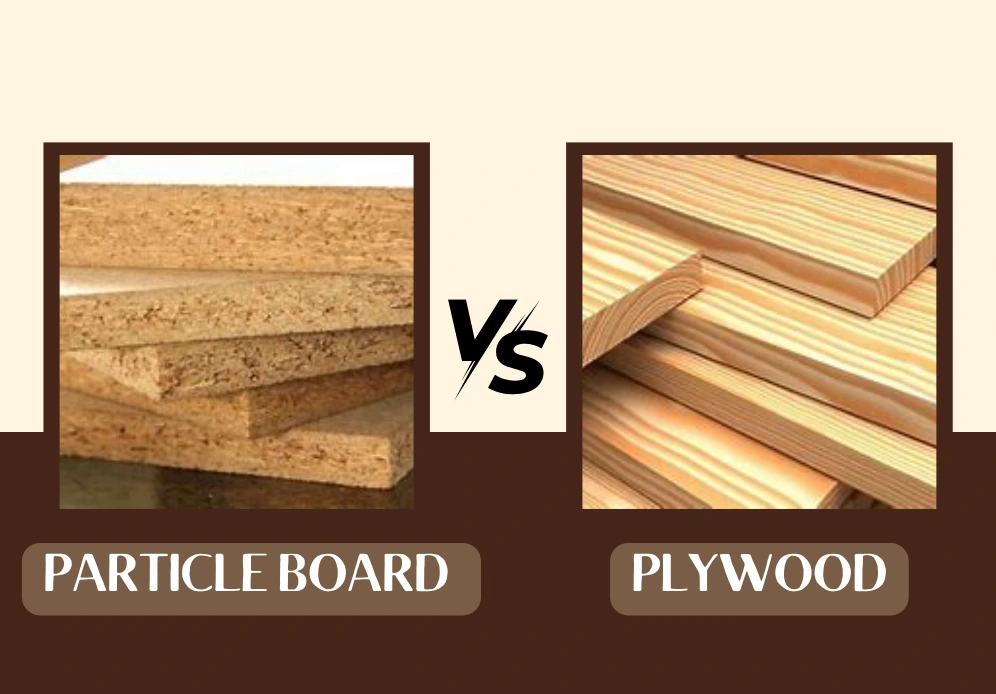Choosing the right material for your woodworking or construction project is crucial for both durability and aesthetics. Two commonly used materials are particle board and plywood. Each offers its own set of unique properties, benefits, and limitations. This guide will delve into the differences between particle board and plywood, helping you make an informed choice for your needs.
What Is Particle Board?
Particle board, also commonly known as chipboard, comprises wood chips, sawmill shavings, and sawdust, which are bonded by adhesives. Due to several advantages such as cost-effectiveness and ease of work, this type of engineered wood has become highly popular in furniture and cabinetry.
What Is Plywood?
Plywood is a material comprising thin layers of wood veneer, or plies, that are bonded together with adhesive. The strength and stability of plywood result from the different grain patterns of the layers from which it is made. Plywood is the most common material used in construction and for high-quality furniture.
Key Differences Between Particle Board And Plywood
- Composition: Particle board is composed of wood particles and adhesive, while plywood consists of layers of veneer.
- Strength and Durability: Plywood is generally stronger and more durable than particle board due to its layered structure.
- Moisture Resistance: Plywood offers better resistance to moisture compared to particle board, which can swell and deteriorate when exposed to water.
- Cost: Particle board is usually less expensive than plywood, making it a budget-friendly option for some projects.
Advantages Of Particle Board
- Cost-Effective: Less expensive than plywood, making it ideal for budget-conscious projects.
- Smooth Surface: The surface of the particle board is smooth, making it suitable for veneering or painting.
- Ease of Handling: Lighter and easier to handle compared to plywood.
Disadvantages Of Particle Board
- Lower Durability: Less durable and weaker than plywood, particularly under heavy loads.
- Moisture Sensitivity: Prone to swelling and warping when exposed to moisture.
- Less Structural Integrity: Not suitable for structural applications where strength is a critical factor.
Advantages Of Plywood
- High Strength: The layered structure of plywood provides excellent strength and stability.
- Moisture Resistance: Better moisture resistance, making it suitable for a range of environments.
- Versatility: Ideal for both structural and aesthetic applications due to its durability and finish options.
Disadvantages Of Plywood
- Higher Cost: Typically more costly compared to particle board.
- Weight: Heavier, which can make handling and installation more challenging.
- Surface Imperfections: Veneer layers may have imperfections that require sanding or finishing.
Ideal Uses For Particle Board
- Furniture: Great for budget-friendly furniture pieces like desks, bookcases, and cabinets.
- Cabinetry: Used in cabinetry where the load-bearing is minimal.
- Decorative Panels: Suitable for decorative applications where structural strength is not a concern.
Ideal Uses For Plywood
- Construction: Often used in structural applications such as flooring, walls, and roofing.
- High-Quality Furniture: Preferred for furniture that requires durability and a fine finish.
- Outdoor Projects: Ideal for projects exposed to the elements due to its moisture resistance.
Comparing Costs
When choosing between particleboard and plywood, you have to consider the cost of materials as well as the long-term costs of durability. While particleboard is lower-cost upfront, plywood’s durability perhaps delivers more value over time, for high-use applications or when an application is under lots of stress.
Environmental Considerations
Both materials have environmental impacts, but they differ in their sustainability. Plywood, especially when sourced from sustainably managed forests, can be more environmentally friendly compared to particle board, which often uses synthetic adhesives that can emit volatile organic compounds (VOCs).
Making The Right Choice
The decision between particle board and plywood depends on your project’s specific requirements. Consider factors like budget, strength, moisture exposure, and aesthetic preferences. For structural or high-durability needs, plywood is often the better choice. For cost-effective and decorative applications, particle board may suffice.
Conclusion
Both particle board and plywood have their places in woodworking and construction. By understanding their differences, advantages, and limitations, you can select the material that best suits your project’s needs. Whether you choose the cost-effective particle board or the durable plywood, making an informed decision will ensure the success of your project.
Frequently Asked Questions (FAQs)
Which Is Better For Outdoor Use, Particle Board Or Plywood?
Generally, plywood has more outdoor usage because it is more resistant to moisture. The use of particle boards outdoors makes them swell and deteriorate due to water exposure. Therefore, plywood can be more reliable in most outdoor projects.
Can Particle Board Be Used For Structural Purposes?
Particle board is not recommended for structural purposes due to its lower strength and durability. For structural applications, plywood is a more suitable option because of its strength and stability.
How do the costs of particle board and plywood compare?
Generally, it is the opposite way around, with particle board being cheaper than plywood. While the upfront cost may be lower with particle board in some cases, the durability of plywood makes it a better value in many long-term or high-stress applications.
Is Plywood Better For Furniture Making Than Particle Board?
Generally, plywood is used for quality furniture making because of its strength and durability; it also resists screws and nails well. Particle board is normally used for cheaper furniture and may not be as resilient.
How Does Moisture Affect Particle Board And Plywood?
While a better choice than particle board for its better resistance to moisture damage causes it to swell and eventually weaken-plywood has an even higher resistance to moisture damage, lowering the aforementioned issues. Plywood is often used in an environment with high humidity or exposure to water.
Are There Any Environmental Concerns With Using Particle Board Or Plywood?
Both have environmental impacts: particle board is more liable to contain synthetic adhesives that will off-gas VOCs. Plywood will be made from trees, sourced from unsustainable forests, contributing to deforestation. Buying plywood from certified sustainable sources lessens the impact of using such a wood product.

